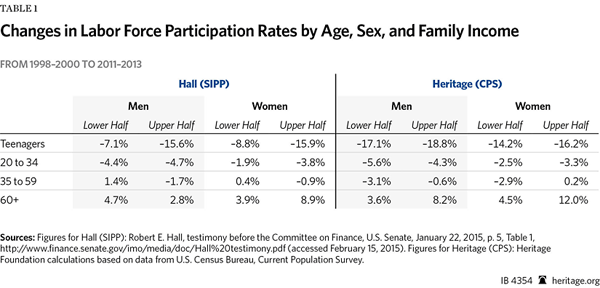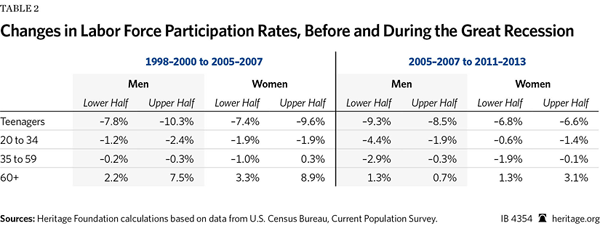Labor force participation in the past few years has been lower than at any time since the 1970s. Heritage Foundation research using Current Population Survey (CPS) data finds that labor force participation decreased more among low-income households than among high-income households. Our finding contradicts results found by Stanford University economist Robert Hall using a separate data source and indicates that more research is needed to fully understand the shifts in labor force participation.
Hall’s Surprising Finding
In testimony before the Senate Finance committee, Hall surprised labor market scholars by presenting new and counterintuitive evidence about labor force participation.[1] Comparing post-recession years (2011–2013) with dot-com boom years (1998–2000), he found that labor force participation had increased in families with below-average income and decreased in families with above-average income.
Hall used the Survey of Income and Program Participation (SIPP) to measure changes over time in labor force participation among families at different levels of income. One potential reason that Hall’s findings were a surprise is that most labor force statistics, including the official unemployment rate, come from a different source, the Current Population Survey. Indeed, when my colleagues and I used the CPS to make the same calculations as Hall, we found very different results.[2] Table 1 shows that, although we found similar results for teenagers (working much less) and seniors (working more), our findings for adults of prime working age contradict Hall’s contention that lower-income adults have been working more.[3]
Business Cycles and Demographics
In addition to examining the entire 1998–2013 change, we looked at how labor force participation changed before and after 2007. Not surprisingly, the changes from 2007 to 2013 are much larger for working-age adults, as Table 2 shows. Labor force participation changes that began before 2007—such as the declining work of those under age 35—reflect evolving labor supply choices rather than just the weak labor market of the post-recession period.
However, statistics that divide workers between lower-half and upper-half households should be interpreted with caution: Income and labor force participation are not independent. Few households have more than two working-age adults. When one of them decides to stop working, the result is usually a significant decrease in household income. Thus, participation and income are closely connected.
Another way to analyze changes in labor force participation is to focus on household demographics, which are much more stable. Using CPS data,[4] we found that the decline in labor force participation rate was greater in households with one prime-working-age adult than in households with two or three. However, because the population of multi-adult households is much larger, more than half of the decline in participation has taken place in multi-adult households.
Table 3 shows that prime-age labor force participation varies across sex, marital status, and household size in systematic ways. It also shows that participation has been declining for several categories of prime-age workers. Labor force participation rates declined steadily for married and unmarried people, for people with and without another working-age adult in the household,[5] and for women as well as men.
James Sherk’s research on labor force participation looked at the reasons why people have left (or never entered) the labor force.[6] Among the young, school is the main reason, especially since far fewer teenagers are working while in school. Among the middle-aged, the number of former workers on disability benefits has increased considerably, despite the general improvement in health and life expectancy. Hall’s testimony shows that as Americans spent less time working, they spent more time sleeping and consuming entertainment.[7]
More Research Needed
More research is necessary to understand why the SIPP and the CPS tell such drastically different stories about labor market participation. In the meantime, the uncertainty is a good reminder that data alone are a poor guide to policy. Economic policies should always be in accordance with maintaining economic freedom and following sound economic theory.
—Salim Furth, PhD, is Senior Policy Analyst in Macroeconomics in the Center for Data Analysis, of the Institute for Economic Freedom and Opportunity, at The Heritage Foundation.





